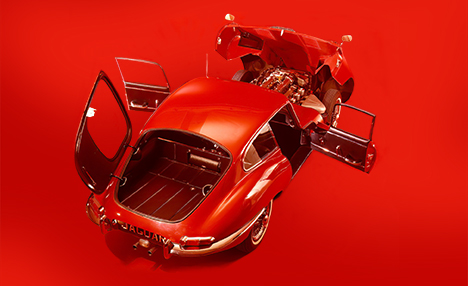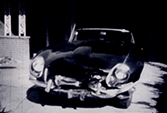From 1954 until the early 1980s, the title of Automobile Aerodynamicist was personified by one man—Frank Costin.
His ability to make racing cars slice through the air better than their competitors became almost legendary, and efforts to copy his techniques took on, sometimes, humorous results. For instance, at one particular race meeting, one of Costin’s designs, a coupe, had developed a problem with exhaust fumes leaking into the cabin. In order to protect the driver, Costin had his men tape up the body seams forward of the firewall. By the time the race began, half the field had their body seams taped over in what they thought had to be the latest Costin demon tweak!
The competition paid this kind of attention because Costin’s designs often incorporated minute details which contributed their own critical element to the reduction of aerodynamic drag. Some of the most successful racers of modern times owed their slippery shapes to Costin’s hand. The Lotus Marks 8, 9, and 11 had body shapes designed entirely by Costin, and the Elite’s beautiful contours were refined by his pen as well.
The world champion Vanwall Formula 1 and the landspeed record-breaking Speedwell Sprites (Moss Motoring, Spring 1997) were also Costin shapes. Unlike many of his predecessors, Costin endowed his automobile bodies with an attribute essential to their success—aerodynamically-induced high speed stability. Unaided by “tucked-on” devices, his cars were known for both their remarkably high top speeds compared to automobiles with similar engine displacement, and their indifference to cross winds or ground effects.
Less appreciated was Costin’s brilliance in the realm of structural design, particularly his timber monocoque chassis for automobiles. Wood had long been used for semi-structural purposes in forming car bodies, but he was the first to use the material to enclose both the occupants and to handle drive train, engine, and suspension loads.
As with his aerodynamic techniques, the technology for high-strength wooden structures was nothing new, and, like Costin himself, had come from the aircraft industry. What made his work so extraordinary was that no one in the automotive world had approached either in a systematic way. It was left to Frank Costin to develop them to their logical conclusions.
In 1968, after a decade and a half of designing primarily racing cars, Costin decided to lay out plans for his ultimate Gran Tourismo. He reckoned there should be some interest in a GT, which incorporated the most advanced engineering principles, and luckily he had the financial backing to build a small number of these cars to test the market.
Costin called his car the Amigo and the most startling aspect of its specification was the timber monocoque chassis. He designed the tub around six torsion boxes. Three ran fore and aft and consisted of deep boxes (or sills) on either side of the cockpit and the transmission tunnel. The sills were strengthened by internal bulkheads, or ribs, placed at 12″ intervals. Three more torsion boxes ran transverse to the structure, one forming the engine bay, the next the cockpit, and the last the trunk and rear suspension housing. A fully enclosed stressed undertray tied all of the boxes together.
The skin consisted of marine plywood and spruce. The internal bulkhead, local reinforcement for suspension pickups, and the like were constructed of non-marine plywood and parana pine. All bonds were made with a synthetic resin adhesive called Aerolite, which, because of its excellent gap-filling properties, required minimal clamping pressure to set. Thus, the production jigs were maintained by simple spring pressure or C clamps.
The chassis featured built-in seats, which were multi-curved sheets of plywood. They were internally boxed as well and were glued to the primary structure, which contributed to the overall chassis rigidity. The steering wheel and pedal group (including a left footrest) slid forward and back on a carriage that was spring loaded towards the rear. Operation was by means of a pull knob on the dash.
The front-hinged bonnet and coupe top were constructed of fiberglass. A thin fiberglass veneer was also applied to all of the exterior wood surfaces of the body and doors in order to produce a smooth enough surface for accepting a top-quality paint job.
Door hinges on a wooden monocoque presented all manner of problems to Costin, but the most reliable, easily maintained and adjusted, proved to be a pair of exterior mounts. These were paired with low drag covers, the top ones incorporating cockpit air intakes that fed air to vents above the door sills.
The Amigo’s body shape was designed with all of the usual Costin aerodynamic elements. The frontal aspect was elliptical in shape, as was the familiar small radiator opening. Efficient cooling was accomplished by fully ducting the airflow, both into and out of, the radiator. For fast warmups or to keep the water temperature up in very cold climates, Costin fit an air foil inside the air intake, which could be adjusted open or closed.
The rear of the Amigo was cut off but was creased to provide both visual relief for what would have been a large flat expanse, and to impart its own measure of rigidity. The roofline was tapered to facilitate airflow to the rear, and the windscreen was bonded in place flush with the bodywork.
The undertray was fully enclosed save for the opening for the differential, gearbox, and sump drains. The exhaust system ran inside the structure and exited through holes in the lower bodywork, just forward of the rear wheels. An air duct aft of the right front wheel fed air to a plenum in the scuttle, which provided additional air to the cockpit. Ventilation was by means of sliding windows, light aircraft style, in the plexiglass side windows.
When Costin laid out the design parameters for the Amigo, he wanted the car to have the ability to cruise at 100 mph with the engine turning less than 5000 mm, all the while returning about 30 miles per gallon! For this task, he chose a remarkably unsporting powerplant, the 2.3 liter four cylinder overhead cam engine from the Vauxhall Victor. Interestingly, the power output was less than 100 bhp at the engine’s redline of 5800 rpm. What Costin knew, however, was that the engine was dead reliable; it had excellent torque characteristics and was very smooth into the bargain.
The Amigo’s gearbox, also Vauxhall Victor, utilized an overdrive on third and top gear which gave 22 mph per 1000 rpm in fourth overdrive. With the 3.9 Victor differential and limited slip as standard Amigo equipment, Costin’s GT could do 0-60 mph in 7.5 seconds and had a top speed of 137 miles an hour. And yes, fuel consumption worked out at 30 miles per gallon! Of course, performance was helped by the car’s 1,450-pound weight and superb aerodynamics.
The suspension and brakes were also taken from the Vauxhall parts bins. These included upper and lower front wishbones, with a Costin-designed adjustable trailing arm. Brakes were stock Victor discs and at the rear, the Amigo was suspended by means of a rigid axle located by parallel leading links and a panhard rod. The brakes in the back were drums. Coil springs were fitted front and rear along with very expensive Koni self-leveling shock absorbers. All this provided excellent handling with neutral cornering characteristics.
As might be expected, because of Costin’s engineering background, the Amigo featured several very novel design elements. For example, the lower rear body panel had a lidded hatch which housed a spare tire. Another hutch on the right side of the hind quarters stored a jack and wheel stay. These spaces were in addition to a normal trunk which could carry a set of golf clubs. The boot lid, incidentally, incorporated a drop-down tray which held a set of hand tools!
The Amigo hod two roll bars, one over the windscreen and another under the rear roof structure. Both were embedded in the fiberglass bodywork and were anchored to local reinforcements in the chassis. The gas tank was an aluminum container housed in its own chamber and was designed to eject on impact! The tank was positioned low in the chassis and offset to balance the driver’s weight.
The Amigo’s extremely low profile of 3 feet 6 inches resulted in an extraordinary optional accessory—the visual warning indicator. This was a roof-mounted, streamlined, fiberglass pylon with a flashing light mounted at the top. The light enabled other traffic to sight the Amigo over hedgerows and walls, and the pylon was a clever place to conceal the radio antenna.
At 13 feet 7 inches, Costin’s Amigo was quite long for a pure two-seater (it was 5 feet 5 inches in width), but the really startling aspect was its price—$8,000! By the time production began in 1972, the price put the Amigo in Jaguar and Porsche company. As it happened, a little too dear for all but seven of the most rabid enthusiasts. Two more cars were built, but were sold off unfinished. Interestingly enough, today, one of them belongs to Ron Costin, Frank’s son.







'The Amigo: The Genius of Frank Costin' have 3 comments
February 22, 2016 @ 12:11 pm Chris Turner
A comprehensive article on the Costin Amigo; you omitted to comment on the built-in directional stability of the vehicle. It was said that you could take your hands off the wheel and light a cigarette at 100 mph and the car would continue on its path. I did see Frank Costin take his hands off the wheel whilst driving my Amigo in the wet (he did not light a cigarette though). He commented that the car veered slightly and that a rear wheel needed balancing (I had had a puncture the day before and the spare wheel was not properly balanced). My car was fitted with the roof pylon although the light did not flash. The triangle of red lights at night caused no end of interest to following cars! The car was also fitted with the Costin Aerodynamic Wing Mirror which Frank had calculated to be worth 3/4 of a b.h.p. at 120 mph. The seats were very comfortable with just the minimum of padding – they followed the Costin Orthopaedic Curve in their shape.
An Amigo fitted with a 1600 c.c. Ford twin-cam engine was entered for the 1971 Six Hour Le Mans race. It was driven by Brian Hart and was leading its class when a puncture put it out of the race. This too was fitted with the Costin Aerodynamic Wing Mirror.
Some of the Amigos were fitted with a NACA duct on the bonnet – a feature Frank had used on the Vanwall and the Le Mans Lotus Elite.
January 10, 2017 @ 2:02 pm Elio Cenci
All Costin’s cars – including Marcos – are indeed fascinating.
By the way, I’ve seen a photo of a space frame “replica” in a website: does anyone know if the moulds of Amigo body shell are still around?
October 29, 2018 @ 1:50 pm Chris Turner
I think that photo of a space frame supporting the Amigo aluminium body may be just that – a metal support for the body from which fibreglass moulds could be taken. It wouldn’t be an Amigo without the wooden chassis – even though Marcos abandoned their wooden chassis for a metal spaceframe in later years.